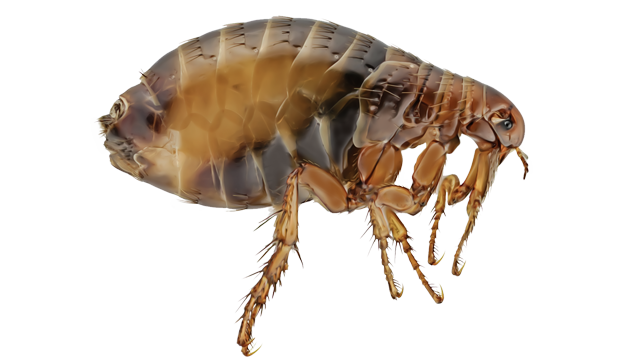Cat Flea

Fleas are considered a super athlete in the insect world because of their ability to jump 100 times their height. However, this little fun fact probably doesn’t bring many smiles to pet owners faces or even those who don’t own pets for that matter. Many of us know how annoying this pest can be. Jumping and biting our legs and causing our pets to go insane.
The cat flea is the most common pest associated with dogs and cats and will spend the duration of their life cycle on the host. These biting pests feed on warm blooded creatures, and like most biting pests, cause itching and discomfort. Fleas can also serve as a host to their own pest, tapeworms. For those that don’t own pets, it should be noted that wildlife can be the source of flea infestations.
The best defense against fleas is a good offense. Fleas can lay 20-50 eggs per day, which means an infestation can get out of control very quickly. Prevention and monitoring can go a long way when it comes to flea control.
Below is a profile of the cat flea and ways to prevent this pest from infesting your property.
| Identification |
|
| Behavior |
|
| Habitat |
|
| Life Cycle (Gradual or Incomplete Metamorphosis) |
|
|
|
| Seasonality |
|
| Favorable Conditions |
|
| Health Concerns |
|
| Signs of an infestation |
|
What You Can Do To Control Fleas When You Have Pets
- Do an inspection of your home. Use the white sock test to find adult fleas. Walk around pet resting areas and other areas in and around the home wearing white socks pulled up to the knee. If fleas are present, they will jump onto socks and be readily visible.
- Treat your animal under the direction of their veterinarian.
- Launder your pet’s bedding
- Vacuum any areas they frequent focusing on cracks and crevices and under furniture - including your car
- Mop all hard floors with copious amounts of soapy water focusing on cracks and crevices
- Install victor flea traps in rooms where you feel you are receiving bites to kill adult fleas and monitor activity
What You Can Do To Prevent Fleas When You Have Wildlife On Your Property
- Do an inspection of the home, inside and outside. Use the white sock test to find adult fleas. Walk around pet resting areas and other areas in and around the home wearing white socks pulled up to the knee. If fleas are present, they will jump onto socks and be readily visible.
- Trap or repel wildlife - Locate areas of activity and trap animal or repel with deterrents.
- Exclude wildlife from your home by repairing structural issues like missing vents
- Vacuum throughout the home focusing on cracks and crevices and under furniture - including your car
- Mop all hard floors with copious amounts of soapy water focusing on cracks and crevices
- Install victor flea traps in rooms where you feel you are receiving bites to kill adult fleas and monitor activity